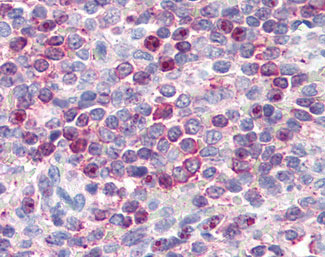Leukotriene B4 Receptor / BLT1 Antibody (Cytoplasmic Domain)
Rabbit Polyclonal Antibody
- SPECIFICATION
- CITATIONS
- PROTOCOLS
- BACKGROUND

Application
| IHC-P |
|---|---|
| Primary Accession | Q15722 |
| Reactivity | Human |
| Host | Rabbit |
| Clonality | Polyclonal |
| Calculated MW | 38kDa |
| Dilution | IHC-P (20 µg/ml) |
| Gene ID | 1241 |
|---|---|
| Other Names | Leukotriene B4 receptor 1, LTB4-R 1, LTB4-R1, Chemoattractant receptor-like 1, G-protein coupled receptor 16, P2Y purinoceptor 7, P2Y7, LTB4R, BLT, BLT1, BLTR, CMKRL1, GPR16, P2RY7 |
| Target/Specificity | Human Leukotriene B4 Receptor. BLAST analysis of the peptide immunogen showed no homology with other human proteins. |
| Reconstitution & Storage | Long term: -70°C; Short term: +4°C |
| Precautions | Leukotriene B4 Receptor / BLT1 Antibody (Cytoplasmic Domain) is for research use only and not for use in diagnostic or therapeutic procedures. |
| Name | LTB4R |
|---|---|
| Synonyms | BLT, BLT1, BLTR, CMKRL1, GPR16, P2RY7 |
| Function | Receptor for extracellular ATP > UTP and ADP. The activity of this receptor is mediated by G proteins which activate a phosphatidylinositol-calcium second messenger system. May be the cardiac P2Y receptor involved in the regulation of cardiac muscle contraction through modulation of L-type calcium currents. Is a receptor for leukotriene B4, a potent chemoattractant involved in inflammation and immune response. |
| Cellular Location | Cell membrane; Multi-pass membrane protein. |
| Tissue Location | Expressed at highest levels in heart, skeletal muscle and at lower levels in brain and liver. High level of expression in lymphoid tissues |
| Volume | 50 µl |

Thousands of laboratories across the world have published research that depended on the performance of antibodies from Abcepta to advance their research. Check out links to articles that cite our products in major peer-reviewed journals, organized by research category.
info@abcepta.com, and receive a free "I Love Antibodies" mug.
Provided below are standard protocols that you may find useful for product applications.
Background
Receptor for extracellular ATP > UTP and ADP. The activity of this receptor is mediated by G proteins which activate a phosphatidylinositol-calcium second messenger system. May be the cardiac P2Y receptor involved in the regulation of cardiac muscle contraction through modulation of L-type calcium currents. Is a receptor for leukotriene B4, a potent chemoattractant involved in inflammation and immune response.
References
Akbar G.K.M.,et al.J. Biol. Chem. 271:18363-18367(1996).
Raport C.J.,et al.J. Leukoc. Biol. 59:18-23(1996).
Yokomizo T.,et al.Nature 387:620-624(1997).
Owman C.S.O.,et al.Genomics 37:187-194(1996).
Kato K.,et al.J. Exp. Med. 192:413-420(2000).
If you have used an Abcepta product and would like to share how it has performed, please click on the "Submit Review" button and provide the requested information. Our staff will examine and post your review and contact you if needed.
If you have any additional inquiries please email technical services at tech@abcepta.com.













 Foundational characteristics of cancer include proliferation, angiogenesis, migration, evasion of apoptosis, and cellular immortality. Find key markers for these cellular processes and antibodies to detect them.
Foundational characteristics of cancer include proliferation, angiogenesis, migration, evasion of apoptosis, and cellular immortality. Find key markers for these cellular processes and antibodies to detect them. The SUMOplot™ Analysis Program predicts and scores sumoylation sites in your protein. SUMOylation is a post-translational modification involved in various cellular processes, such as nuclear-cytosolic transport, transcriptional regulation, apoptosis, protein stability, response to stress, and progression through the cell cycle.
The SUMOplot™ Analysis Program predicts and scores sumoylation sites in your protein. SUMOylation is a post-translational modification involved in various cellular processes, such as nuclear-cytosolic transport, transcriptional regulation, apoptosis, protein stability, response to stress, and progression through the cell cycle. The Autophagy Receptor Motif Plotter predicts and scores autophagy receptor binding sites in your protein. Identifying proteins connected to this pathway is critical to understanding the role of autophagy in physiological as well as pathological processes such as development, differentiation, neurodegenerative diseases, stress, infection, and cancer.
The Autophagy Receptor Motif Plotter predicts and scores autophagy receptor binding sites in your protein. Identifying proteins connected to this pathway is critical to understanding the role of autophagy in physiological as well as pathological processes such as development, differentiation, neurodegenerative diseases, stress, infection, and cancer.


